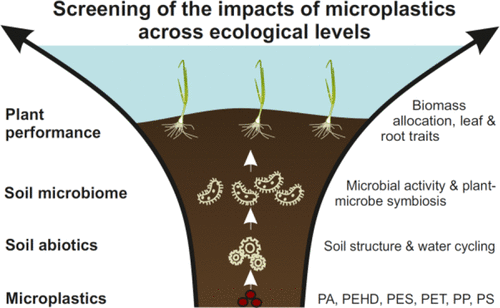当前位置:
X-MOL 学术
›
Environ. Sci. Technol.
›
论文详情
Our official English website, www.x-mol.net, welcomes your
feedback! (Note: you will need to create a separate account there.)
Microplastics Can Change Soil Properties and Affect Plant Performance
Environmental Science & Technology ( IF 10.8 ) Pub Date : 2019-05-07 , DOI: 10.1021/acs.est.9b01339 Anderson Abel de Souza Machado 1, 2, 3 , Chung W. Lau 1, 2, 4 , Werner Kloas 2, 5 , Joana Bergmann 1, 3 , Julien B. Bachelier 1 , Erik Faltin 1, 2 , Roland Becker 6 , Anna S. Görlich 1 , Matthias C. Rillig 1, 3
Environmental Science & Technology ( IF 10.8 ) Pub Date : 2019-05-07 , DOI: 10.1021/acs.est.9b01339 Anderson Abel de Souza Machado 1, 2, 3 , Chung W. Lau 1, 2, 4 , Werner Kloas 2, 5 , Joana Bergmann 1, 3 , Julien B. Bachelier 1 , Erik Faltin 1, 2 , Roland Becker 6 , Anna S. Görlich 1 , Matthias C. Rillig 1, 3
Affiliation

|
Microplastics can affect biophysical properties of the soil. However, little is known about the cascade of events in fundamental levels of terrestrial ecosystems, i.e., starting with the changes in soil abiotic properties and propagating across the various components of soil–plant interactions, including soil microbial communities and plant traits. We investigated here the effects of six different microplastics (polyester fibers, polyamide beads, and four fragment types: polyethylene, polyester terephthalate, polypropylene, and polystyrene) on a broad suite of proxies for soil health and performance of spring onion (Allium fistulosum). Significant changes were observed in plant biomass, tissue elemental composition, root traits, and soil microbial activities. These plant and soil responses to microplastic exposure were used to propose a causal model for the mechanism of the effects. Impacts were dependent on particle type, i.e., microplastics with a shape similar to other natural soil particles elicited smaller differences from control. Changes in soil structure and water dynamics may explain the observed results in which polyester fibers and polyamide beads triggered the most pronounced impacts on plant traits and function. The findings reported here imply that the pervasive microplastic contamination in soil may have consequences for plant performance and thus for agroecosystems and terrestrial biodiversity.
中文翻译:

微塑料可以改变土壤性质并影响植物性能
微塑料会影响土壤的生物物理特性。然而,人们对陆地生态系统基本水平上的级联事件一无所知,即从土壤非生物特性的变化开始,并传播到土壤与植物相互作用的各个组成部分,包括土壤微生物群落和植物性状。我们在这里研究了六种不同的微塑料(聚酯纤维,聚酰胺珠和四种片段类型:聚乙烯,聚酯对苯二甲酸酯,聚丙烯和聚苯乙烯)对一系列代表土壤健康和大葱性能的替代物(葱属瘘)的影响)。观察到植物生物量,组织元素组成,根系性状和土壤微生物活性发生了显着变化。这些植物和土壤对微塑料暴露的反应被用来为影响机理提出因果模型。影响取决于颗粒类型,即形状与其他天然土壤颗粒相似的微塑料与对照相比差异较小。土壤结构和水动力学的变化可能解释了观察到的结果,其中聚酯纤维和聚酰胺珠引发了对植物性状和功能的最显着影响。此处报道的发现表明,土壤中普遍存在的微塑料污染可能对植物的生长性能,进而对农业生态系统和陆地生物多样性产生影响。
更新日期:2019-05-16
中文翻译:

微塑料可以改变土壤性质并影响植物性能
微塑料会影响土壤的生物物理特性。然而,人们对陆地生态系统基本水平上的级联事件一无所知,即从土壤非生物特性的变化开始,并传播到土壤与植物相互作用的各个组成部分,包括土壤微生物群落和植物性状。我们在这里研究了六种不同的微塑料(聚酯纤维,聚酰胺珠和四种片段类型:聚乙烯,聚酯对苯二甲酸酯,聚丙烯和聚苯乙烯)对一系列代表土壤健康和大葱性能的替代物(葱属瘘)的影响)。观察到植物生物量,组织元素组成,根系性状和土壤微生物活性发生了显着变化。这些植物和土壤对微塑料暴露的反应被用来为影响机理提出因果模型。影响取决于颗粒类型,即形状与其他天然土壤颗粒相似的微塑料与对照相比差异较小。土壤结构和水动力学的变化可能解释了观察到的结果,其中聚酯纤维和聚酰胺珠引发了对植物性状和功能的最显着影响。此处报道的发现表明,土壤中普遍存在的微塑料污染可能对植物的生长性能,进而对农业生态系统和陆地生物多样性产生影响。






























 京公网安备 11010802027423号
京公网安备 11010802027423号